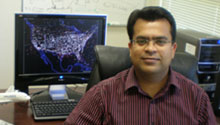 CUDA Spotlight: GPU-Accelerated Air Traffic Management by Nadeem Mohammad, posted Mar 12 2012 at 10:39PM Our new spotlight is on Dr. Monish Tandale, a Research Scientist at Optimal Synthesis Inc. (OSI), based in Los Altos, California. This interview is part of the CUDA Spotlight Series. NVIDIA: Monish, tell us about Optimal Synthesis. NVIDIA: Monish, tell us about Optimal Synthesis. OSI's research focus areas include Missiles and High Performance Aircraft, NextGen Air Traffic Management Systems and Signal Processing. The company's expertise includes mathematical modeling, computer simulation, analysis, estimation, automatic control and optimization for complex dynamic systems and processes. Since 2007, high-performance computing with GPUs has been one of our core competencies. NVIDIA: Why is traffic flow management important? Air traffic flow management involves balancing air traffic demand with system capacity in the NAS and managing the traffic flow in a safe, efficient, and coordinated manner. Effective traffic flow management not only increases passenger safety, but also mitigates economic costs associated with flight cancellation and delays, and environmental costs associated with excessive fuel burn during airborne flight delays. NVIDIA: Tell us about your work with the NASA Ames Research Center. Our project is focused on predicting the "4-Dimensional Trajectory (4DT)" for every aircraft in the NAS. A 4DT describes the 3-dimensional position (latitude, longitude, altitude) of aircraft at regular time intervals (time is the 4th dimension). In the paradigm of 4DT operations, all air traffic control decisions are performed based on the predicted 4DT, i.e. the predicted position of the aircraft in the future. This project resulted in the development of CARPAT™ (Computational Appliance for Rapid Prediction of Aircraft Trajectories). NVIDIA: How does GPU computing play a role in your work? GPU computing allows us to exploit the parallelism in the trajectory prediction process to have extremely fast run-times. This in turn allows us to achieve real-time performance and analyze models with greater complexity, and opens up the possibility of utilizing algorithms and approaches that were earlier deemed impractical due to the computational complexity. NVIDIA: What kind of advantages have you achieved with GPU computing? NVIDIA: When you think about the future of air traffic management, what will be the biggest change from today? With increasing computational capability available at our disposal, we can develop and analyze highly complex traffic flow models and run optimization algorithms to generate optimal schedules and routing of aircraft in the NAS to achieve the maximum possible efficiency. The goal is to use automation to allow more people to fly without being inconvenienced by congestion and delayed flights. NVIDIA: Are you working on any other projects using GPU computing? * * * * * * * * * * * * * * * * * * * * * * * * * * * * * * * * * * * * * * * * * * * * * * * * * * * * * * * * * * * * * * * * Bio for Dr. Monish Tandale: Relevant Links: Presentation at the NVIDIA GPU Technology Conference (GTC) 2010, San Jose, CA: http://nvidia.fullviewmedia.com/gtc2010/0921-l-2214.html Air Traffic Management Research at the NASA Ames Research Center: http://www.aviationsystemsdivision.arc.nasa.gov/research/index.shtml NASA’s Future ATM Concepts Evaluation Tool (FACET):http://www.aviationsystemsdivision.arc.nasa.gov/research/modeling/facet.shtml Website: http://sites.google.com/site/monishtandale Contact Info: |